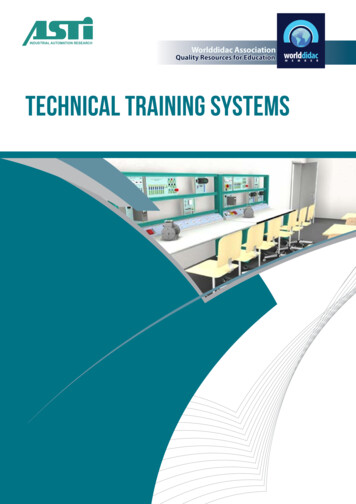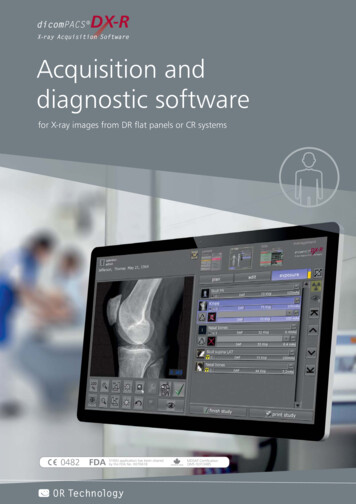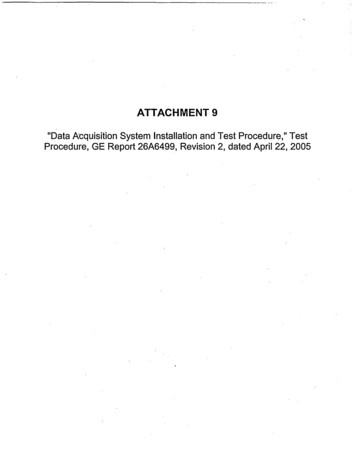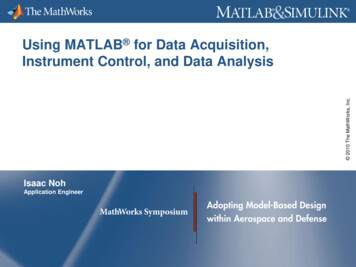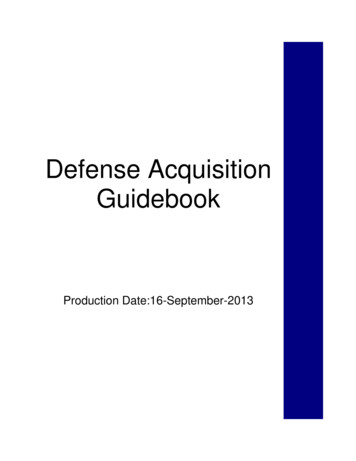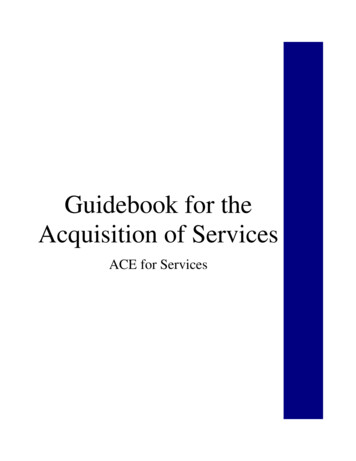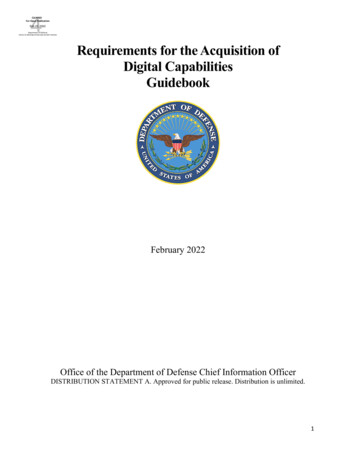
Transcription
CLEAREDFor Open PublicationFeb 23, 2022Department of DefenseOFFICE OF PREPUBLICATION AND SECURITY REVIEWRequirements for the Acquisition ofDigital CapabilitiesGuidebookFebruary 2022Office of the Department of Defense Chief Information OfficerDISTRIBUTION STATEMENT A. Approved for public release. Distribution is unlimited.1
Approved bysigned byMETZ.DANIELLE.A.12958 DigitallyMETZ.DANIELLE.A.129585104651046Date: 2022.02.10 12:50:13 -05'00'Ms. Danielle MetzDeputy CIO (DCIO) for the Information Enterprise (IE)Office of the Chief Information OfficerDateRequirements for the Acquisition of Digital Capabilities Guidebook Change RecordDate1/3/2022ChangeVersion 1.0RationaleRevised and incorporatedcontent from the DefenseAcquisition Guidebook, Chapter6, and the DoD CloudComputing AcquisitionGuidebook, to reflect alignmentwith DoDI 5000.82,Requirements for theAcquisition of DigitalCapabilities, and the AdaptiveAcquisition Framework.2
Contents1. Introduction . 42. Purpose . 43. Scope. 54. Adaptive Acquisition Framework Pathways . 64.1 Requirements Validation . 74.2 Acquisition Planning . 74.3 Approve . 124.4 Acquisition Management . 144.5 Acquisition Pathways Table . 155. Sustaining Digital Capabilities – Post-Implementation Review. 226. Cloud Acquisition Guidance . 226.1 Requirements Validation . 236.2 Acquisition Planning . 236.3 Approve . 246.4 Acquisition Management . 246.4.1 Security . 246.4.2 Data . 286.4.3 Cost . 296.4.4 Contracting . 336.4.5 Service Level Agreements (SLAs) . 397. Additional Resources . 498. Version and Revision History . 503
1. IntroductionCapabilities of the Department of Defense (DoD) are becoming increasingly connected and, as such,increasingly complex. Through concepts like the modular open systems approach and greaterabstraction through commodity-like platforms providing compute and store, DoD continues to evolvetoward an information enterprise where digital capabilities are the norm, and integration and securityare more critical than ever. For the purposes of this guidance, a digital capability refers to a capabilityacquired through the DoD Adaptive Acquisition Framework that contains a component of informationtechnology (IT) to include National Security Systems (NSS), networking, cybersecurity, electromagneticspectrum, and/or positioning, navigation, and timing, pursuant to the relevant sections of Titles 10, 40,and 44 of United States Code (U.S.C.) and National Security Directive 42. Examples of capabilities thatfall under this definition to include other terms that apply are provided in Section 3, Scope.DoDI 5000.82, Requirements for the Acquisition of Digital Capabilities, provides the policies,responsibilities, and overarching procedures to ensure that digital capabilities acquired through the DoDAdaptive Acquisition Framework support the priorities of the National Defense Strategy and DoD DigitalModernization Strategy, and are interoperable and secure. In not just complying with, but inimplementing DoDI 5000.82, acquisition decision authorities, information technology functionalsponsors, Functional Service Managers (FSMs), and Program Managers (PMs) will achieve saidoutcomes. This guidebook is an extension of DoDI 5000.82 and provides additional detail inimplementing the policy across all acquisition pathways. For specific procedures concerning engineering,test and evaluation, intellectual property, cybersecurity, or products support, this guidebook defers toappropriate policies (e.g., DoDI 5000.88, 5000.89, 5010.44, 5000.90, and 5000.91 respectively) and theirassociated guidebooks. For questions concerning DoDI 5000.82 or this guidebook, DoD Componentsmay contact DODCIO-itpfm@groups.mail.mil.2. PurposeThe purpose of this guidebook is to provide easy-to-understand guidance for implementing theprocedures of DoDI 5000.82. It is intended for the acquisition community to include PMs and FSMs.Content is organized as follows: Scope: This section provides the definitions of terms applicable to this guidance.Adaptive Acquisition Framework Pathways: This section begins with guidance that appliesacross all acquisition pathways organized by major stages of the acquisition and follows witha table that identifies unique guidance for each pathway. Guidance is organized under thestages of requirements validation, acquisition planning, approve, and acquisitionmanagement.Sustaining Digital Capabilities: This section provides DoD guidance regarding sustainment.Cloud Acquisition Guidance: Due to the unique requirements in acquiring cloud services, thisguidebook provides a separate section on cloud acquisition guidance.Additional Resources: This section provides links to referenced material related to DoDI5000.82. Referenced material includes systems, portals, and documentation.Version and Revision History: This section provides a timeline of updates made to thedocument since its inception.4
3. ScopeThis guidance applies to digital capabilities as defined in the introduction, but excludes equipmentacquired by contractors that is incidental to the performance of a DoD contract, such as telephones,computers, and fax machines, plus any acquisition using non-appropriated funds under the guidelinesoutlined in DoDI 4105.67. Table 1 below provides the definition of terms within the scope of thisguidance to include examples.Table 1: Applicable Terms and DefinitionsTermDigital CapabilityDefinition (source)A capability acquired through the DoD AdaptiveAcquisition Framework that contains a component of ITto include NSS, networking, cybersecurity,electromagnetic spectrum, and/or positioning,navigation, and timing, pursuant to the relevant sectionsof Titles 10, 40, and 44 of United States Code (U.S.C.)and National Security Directive 42.InformationTechnology (IT)As defined in Title 40 U.S.C., Section 11101; an excerpt isincluded below; see Title 40 U.S.C. for full definition.National SecuritySystem (NSS)Any equipment or interconnected system or subsystemof equipment, used in the automatic acquisition,storage, analysis, evaluation, manipulation,management, movement, control, display, switching,interchange, transmission, or reception of data orinformation by the executive agency, if the equipment isused by the executive agency directly or is used by acontractor under a contract with the executive agencythat requires the use- of that equipment; or- of that equipment to a significant extent in theperformance of a service or the furnishing of aproduct.As defined in Title 40 U.S.C., Section 11103; an excerpt isincluded below; see Title 40 U.S.C. for full definition.A telecommunications or information system operatedby the Federal Government, the function, operation, oruse of which involves intelligence activities; involvescryptologic activities related to national security;involves command and control of military forces;involves equipment that is an integral part of a weaponor weapons system; or is critical to the direct fulfillmentof military or intelligence missions.Example(s)Information system, NSS,Defense Business System (DBS),software application, weaponsplatform with embeddedsoftware, networks, computeplatforms (e.g., data centersand cloud), softwaredevelopment platforms (e.g.,DevSecOps platforms)Infrastructure to supporttransport, networking,compute and store, andmonitoring and controlsystems; computers; ancillaryequipment; software;firmware; services (includingsupport services)Command and control system;embedded software for aweapons platform withpositioning, navigation, andtiming component; or atelecommunications orinformation system that isprotected at all times byprocedures established forinformation that has beenspecifically authorized undercriteria established by anExecutive order or an Act ofCongress to be kept classified inthe interest of national defenseor foreign policy. (Title 44U.S.C., Section 3552)5
InformationSystemApplicationEmbeddedSoftwareIT ServiceAs defined in Title 44 U.S.C., Section 3502; an excerpt isincluded below; see Title 44 U.S.C. for full definition.A discrete set of information resources organized for thecollection, processing, maintenance, use, sharing,dissemination, or disposition of information; whereinformation resource is information and relatedresources, such as personnel, equipment, funds, and ITper Title 44 U.S.C., Section 3502.As defined in Committee on National Security Systems(CNSS) Glossary, CNSSI No. 4009.A software program hosted by an information system.As defined in DoD Instruction 5000.87, Operation of theSoftware Acquisition Pathway.Software with a dedicated function within a largermechanical or electrical system, often with real-timecomputing constraints, or software applicationsembedded in a platform (e.g., air vehicle, groundvehicle, or ship). In the context of this issuance,embedded software does not apply to firmware orsoftware dedicated to controlling devices.For the purposes of this guidance, the performance ofany services work related to IT and the operation of IT,including NSS. This includes outsourced IT-basedbusiness processes, outsourced IT, and outsourcedinformation functions.NSS, DBSNSS, DBS, embedded software,internal use software, webbased applications, mobileapplicationsGlobal Positioning Systemcomponent in a larger weaponsplatform; software componentin a wearable device connectedto a DoD networkCloud services to includesoftware as a service, softwaremaintenance as a service, ITmaintenance, and softwareassuranceThis guidebook does not address content already defined or articulated in other policies of the AdaptiveAcquisition Framework to include pathway and other functional issuances. Where appropriate,references to other issuances are cited.4. Adaptive Acquisition Framework PathwaysThere are six acquisition pathways under the Adaptive Acquisition Framework. Generally, all pathwaysconsist of the following activities: requirements validation, acquisition planning, approval, andacquisition management (Figure 1). This guidebook uses the construct in Figure 1 to organizeinformation. It provides guidance in the order of recommended execution. For example, initial ClingerCohen Act compliance criteria may occur during requirements validation with remaining criteriaaddressed during acquisition planning. Guidance in this section applies to all acquisition pathways. Atable is included at the end of this section to address activities where unique pathway guidance exists.Figure 1: Framework for Organizing DoDI 5000.82 Guidance6
4.1 Requirements ValidationAll pathways require some sort of requirements validation as directed in associated pathway policies. Indefining requirements, PMs should consider the following as it pertains to the IT; networking;cybersecurity; electromagnetic spectrum; positioning, navigation, and timing; data; and/or recordsmanagement components of their digital capabilities.Clinger-Cohen Act (CCA) ComplianceThe intent of CCA compliance is to ensure that DoD smartly manages IT investments. Acquisition ofdigital capabilities must align with the priorities of the Department in furthering mission objectives andwith investment decisions made during the Planning, Programming, Budgeting and Execution (PPBE)process. CCA compliance begins with requirements validation and consists of two steps.1. Validate Strategic Alignment: In identifying requirements, PMs should ensure that requirementsalign with and further the objectives of the National Defense Strategy and the DoD DigitalModernization Strategy. The DoD Digital Modernization Strategy and associated sub-strategiesare located in Section 7, Additional Resources. Validation of alignment with strategic directionshould be built into artifacts generated during the requirements validation process. Forembedded software, strategic alignment validation resides at the overarching program levelwhere the embedded software integrates.2. Validate Investment Decision Alignment: PMs should work with their Comptroller/ChiefFinancial Officers to ensure that resources are available and align to budgetary decisions. (Fordigital capabilities, these decisions are informed by the investment and IT portfolio managementprocesses of the Department per DoDD 8115.01 and DoDI 8115.02.) Validation of alignmentwith investment decisions may be a simple understanding of available funding sources oridentified program elements of the DoD Component’s budget.4.2 Acquisition PlanningAcquisition planning includes those activities required prior to approval of a solicitation release. Theseactivities differ depending on pathway but consist of translating requirements into solutionrequirements and developing an acquisition strategy or acquisition strategy-like artifact.Clinger-Cohen Act (CCA) ComplianceCCA compliance continues at this point in the acquisition. In translating requirements into solutionrequirements, PMs should take the following next steps:1. Build CCA Compliance into the Acquisition Strategy: PMs should consider and address thefollowing questions in the acquisition strategy, acquisition strategy-like artifact, and/or businesscase or cost assessment analysis.a. Can solution requirements be fulfilled by an available enterprise service, enterprisecontract, or commercial-off-the-shelf (COTS) technology? Available enterprise services,enterprise contracts, and approved COTS are located at https://www.esi.mil/. PMs should consider government contracting laws and regulations andsuitability of using DoD IT Category Management best-in-class purchasingsolutions, DoD ESI, Federal Category Management procurement vehicles, andDoD-wide Joint Enterprise License Agreements and DoD Component-levelenterprise software licenses. PMs should document these considerations andinclude selection rationale.7
b. Is the cost for meeting solution requirements appropriately justified?c. Are sufficient resources available in alignment with budgetary decisions? PMs should align acquisitions with an investment registered in the DefenseInformation Technology Investment Portal (DITIP)/Select and NativeProgramming Data Input System for Information Technology (SNaP-IT).d. Does the acquisition comply with the requirements of DoDI 5000.82?e. How will the acquisition program measure success? PMs should document measures ofsuccess against desired operational outcomes. PMs should be prepared to review thesemeasures of success during post-implementation review.2. Register Acquisition in the Defense IT Portfolio Repository/Secret IT Repository (DITPR/SITR):PMs should initially register their acquisition in DITPR or SITR. This includes mission-critical andmission-essential systems. PMs should complete all required fields.Information Enterprise ArchitectureAll acquisitions for digital capabilities should comply with the Information Enterprise Architecture (IEA)and associated architecture guidance (e.g., reference architectures and reference designs) of theDepartment. The IEA provides the overarching principles, rules, and standards for guiding solutionsdevelopment. To ensure alignment with the IEA, PMs should do the following:1. Review Relevant IEA Artifacts: PMs should review relevant architecture guidance associatedwith their particular acquisition and validate that their solution requirements are within thebounds of the architecture. PMs should include solicitation language that requires compliancewith applicable reference architectures as appropriate.2. Implement IT Standards: PMs should use standards from the currently approved version of theDoD IT Standards Registry within the Global Information Grid Technical Guidance Federation.PMs should be prepared to test interoperability requirements and document thoserequirements in appropriate artifacts per DoDIs 5000.89, DoDI 8330.01, DoDI 8310.01, DoDI8320.02, and 8510.01. PMs should be aware of the records or data associated with records fortheir acquisition to better plan for portability of records during their lifespan across subsequentacquisition lifecycle boundaries in accordance with DoDI 5015.02.3. Promote Modular Open Systems Approach: PMs should consider solutions with a modular opensystems approach and if appropriate, include contract language that requires a modular opensystems approach or the needed capabilities to integrate the acquired solution with otherrelevant solutions or platforms.CybersecurityCybersecurity requirements exist across multiple policies, but the fundamental policies are DoDIs8500.01, 8510.01, and 8530.01. Adaptive Acquisition Framework policies for cybersecurity are DoDIs5000.90, 5000.83, and 5000.82. This guidance will address only those requirements specified in DoDI5000.82 with reference to other policies as appropriate.Cybersecurity must be addressed early in acquisition planning and apply across all phases of theacquisition and at each technical layer of the solution. PMs and the system owners are responsible forthe following:1. Develop Cybersecurity Strategy: Milestone Decision Authorities (MDAs), Decision Authorities(DAs), IT functional sponsors, PMs, and FSMs should work together to develop a cybersecuritystrategy that outlines plans for and implementation status of projected cybersecurity activities8
across all phases of the digital capability’s lifecycle. It should be regularly updated throughoutthe system lifecycle in accordance with DoDI 5000.90 and DoDI 8580.1. The strategy should bedeveloped in coordination with program protection methods and practices and included as anappendix to the program protection plan (PPP) in accordance with cybersecurity policy (DoDI8580.1) and the artifacts described in appropriate pathway policies. It may also exist as a standalone artifact or as part of the Acquisition Strategy if there is no PPP. Further guidance regardinghow to develop a cybersecurity strategy is available in the DoD Cyber Security Strategy Outlineand Guidance via the Risk Management Framework (RMF) Knowledge Service as well as the DoDCybersecurity T&E Guidebook.2. Identify Level of Risk Acceptance and Associated Security Controls: PMs and system ownersshould begin working with their cybersecurity team to determine acceptable level of risk andassociated security controls for proposed solution requirements.3. Identify Cyber Supply Chain Risk: PMs should identify potential supply chain risk in accordancewith DoDI 5200.44 and ensure testing addresses those risks in accordance with DoDI 5000.89.PMs should utilize appropriate provisions and clauses of DFARS section 252.204 and reportmission critical threats and vulnerabilities that cannot be addressed to the appropriateacquisition decision authority, authorizing official, and the Supply Chain Risk Management(SCRM) portal.System Security EngineeringSystem Security Engineering (SSE) planning activities should be integrated for the acquisition of digitalcapabilities and documented in the Program Protection Plan (PPP) in accordance with the PPP Outlineand Guide (O&G) and DoDI 5000.88. Statutory program protection planning must be accomplished forMajor Defense Acquisition Programs and Major Systems (defined in 10 USC 3041 and 3042 effectiveJanuary 1, 2022), unless waived in accordance with statutory authority.DataThe DoD Data Strategy envisions DoD as a data-centric organization that uses data at speed and scale foroperational advantage and increased efficiency. PMs should maximize the sharing of data to achieve thisvision. Additional information and resources are available at https://www.data.mil.During acquisition planning, PMs should plan for the following when developing solution requirements:1. Publication of high-value data assets and all associated interfaces, systems, and applications inthe DoD federated data catalog (ADVANA).2. Use of Application Programming Interfaces (APIs) and other common interoperabilitymechanisms to provide access to data assets by authorized users.3. Storage of data in a manner that is platform and environment-agnostic, uncoupled frominfrastructure dependencies, and maximally portable.4. Management of all data assets acquired or produced in a way that promotes enterpriseinteroperability.PMs should maximize data sharing and data use rights by including appropriate language in thesolicitation. Data rights is a shorthand way to refer to the Government's license rights in majorcategories of valuable intellectual property, and it factors critically into how a capability is contracted forand how data is managed for the life of a program.9
It is important to emphasize that data should be secured and controlled like any other high value assetand PMs should confidently use it as a negotiating point to gain appropriate protections and returns oninvestment. As such, PMs should mandate contractual provisions that provide for the maximum DoDownership and controls possible, thereby allowing the Department to share, restrict, and use dataconsistent with its financial, security, and other interests.Although often not achievable, as a benchmark for negotiations, the government should ideally retain allrights to the data, have the ability to transfer it to other storage locations at its discretion, and ensurethat the data is maintained in a consistent format to enable transfer methodologies, mechanisms, andtools. The format or storage location of the data should not dictate the technology used to gain insightsinto the data and all data (current and historical) should be available for download by government orgovernment appointed representatives via a commercial standard Application Program Interface. PMsshould use these criteria as a benchmark for negotiations, considering the unique circumstances of eachcontract and the data rights provisions thereof.Data rights for technical data and computer software fall into eight categories:CategoriesUnlimited RightsGovernment PurposeRightsLimited RightsRestricted RightsSpecificallyNegotiated LicenseRightsSmall BusinessInnovative Research(SBIR) Data RightsCommercial TechnicalData License RightsCommercial ComputerSoftware LicensesTable 2: Data Rights CategoriesDefinitionDeveloped exclusively at Government expense and for certain types of data (e.g.,Form, Fit, and Function [FFF]; Operation, Maintenance, Installation, and Training[OMIT]). These rights involve the right to use, modify, reproduce, display, release, ordisclose technical data in whole or in part, in any manner, and for any purposewhatsoever, and to have or authorize others to do so.This right involves the right to use, duplicate, or disclose technical data forGovernment purposes only, and to have or permit others to do so for Governmentpurposes only. Government purposes include competitive procurement, but do notinclude the right to permit others to use the data for commercial purposes.A limited rights agreement permits the Government to use proprietary technical datain whole or in part. It also means that the Government has to obtain the expressedpermission of the party providing the technical data to release it, or disclose it, outsidethe Government.Developed exclusively at private expense.This right pertains whenever the standard license arrangements are modified to themutual agreement of the contractor and the Government. In this case, the exact termsare spelled out in a specific license agreement unique to each application.All technical data or computer software generated under a SBIR contract. Governmentusers cannot release or disclose outside the Government except to Governmentsupport contractors.Applies to technical data related to commercial items (developed at private expense).Managed in the same manner as Limited Rights.Applies to any commercial computer software or software documentation. Managedas specified in the commercial license offered to the public.A PM should ensure that all technical data and computer software and related license rights required forprocurement and sustainment of a system are available throughout a system’s lifecycle in accordancewith IP guidance (see DoDI 5010.44).10
PMs should identify the data comprised by records, record control schedules, and any recordsmanagement process data necessary to understand record status when records are removed from theacquired capability (see DoDI 5015.02).Functional Policy ComplianceDuring acquisition planning, PMs should ensure that their solution requirements comply with DoD ITpolicy. Table 3 provides a reference for policies pertaining to specific functional tPositioning,Navigation, andTiming (PNT)Cloud tionProtectionPrivacyInformationQualityTable 3: Functional PoliciesDescriptionA waveform is an electromagnetic signal-in-space, typically definedby Open Systems Interconnection model layers 1 through 3, alongwith the controls and processes for a desired function orapplication. These processes do not include the message content.Policy establishes procedures for the management of waveforms.Electromagnetic spectrum or spectrum is the range of all types ofelectromagnetic radiation. Policy establishes procedures for themanagement and use of spectrum.Policy establishes procedures for the management of the DoD PNTenterprise, PNT cybersecurity, precise time and time interval, andcelestial reference frame.Cloud computing is a model for enabling ubiquitous, convenient,on-demand network access to a shared pool of configurablecomputing resources (e.g., networks, servers, storage,applications, and services) that can be rapidly provisioned andreleased with minimal management effort or service providerinteraction.PMs should properly account for and report software maintenanceand sustainment.The ability of systems, units, or forces to provide data,information, materiel, and services to, and accept the same from,other systems, units, or forces, and to use the data,information, materiel, and services exchanged to enable them tooperate effectively together. IT interoperability includes both thetechnical exchange of information and the end-to-end operationaleffectiveness of that exchange of information as required formission accomplishment. Interoperability is more than justinformation exchange. It includes systems, processes, procedures,organizations, and missions over the lifecycle and must bebalanced with cybersecurity.For digital capabilities that collect, maintain, use, or disseminateinformation, PMs should ensure information is protected andmeasures are in place to prevent unauthorized disclosure.Protection of critical program information and related intellectualproperty should be, as appropriate, documented in the PPP.PMs should ensure personally identifiable information is managedin a manner that protects privacy and conforms to applicable legal,regulatory, and policy requirements regarding privacy.Quality of information publicly distributed by PMs should meetbasic information quality standards with the attributes of utility,Policy ReferenceDoDI 4630.09DoDI 4650.01DoDI 4650.05DoDI 4650.08Section 6, CloudAcquisition GuidanceDoDI 4151.20DoDI 5000.83DoDI 8330.01DoDI 8320.02DoDI 5200.01DoDI 5000.83DoDI 5000.90DoDI 5400.11DoD 5400.11-RDoDI 5400.16DoDI 8170.01DoDI 3200.1211
Intelligence DataRecordsManagementobjectivity, and integrity. This includes scientific and technicalinformation.PMs in Defense Intelligence Com
implementing DoDI 5000.82, acquisition decision authorities , information technology functional sponsors, Functional Service Managers (FSMs), and Program Managers (PMs) will achieve said outcomes. This guidebook is an extension of DoDI 5000.82 and provides additional detail in implementing the policy across all acquisition pathways.





